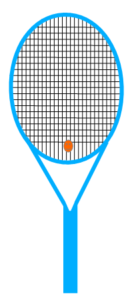Tennis damper for beginners
Learn which tennis damper is best for tennis beginners
Tennis damper for beginners
Many tennis beginners finally have their own tennis racket in their hands, know the advantages and disadvantages of the different tennis strings and how a grip tape is wound, but what is the point of a damper in tennis? Should I play tennis with or without a damper?
Some professional tennis players always play with a damper in their tennis racket while others always play without a tennis damper. So what’s really behind this little tennis accessory? We do the damper test.
Below we explain what a damper really brings, how the damper is properly attached in the tennis racket and name the cost of a tennis damper – enjoy reading.
1. Tennis damper introduction
A tennis damper was not yet necessary at the time of the emergence of tennis, because at first tennis was played only by hand and later with tennis rackets made entirely of wood.
Over time, the wooden racket was replaced by the tennis rackets known today and the tennis damper, also known as a vibration damper in tennis, was invented in 1964. The small tennis accessory is made of silicone or hard rubber and adorns many tennis rackets of tennis beginners, advanced or professional tennis players.
2. Features of tennis dampers
The tennis damper is designed to further optimize one’s tennis game in conjunction with the tennis racket.
The most important properties of tennis dampers are explained below:
a) Reduction of vibrations
The tennis damper is designed to reduce the vibrations of the tennis string after the tennis ball has been hit. At the same time, a possible injury, e.g. tennis elbow, is to be prevented by a reduced energy transfer into the hitting arm.
Many tennis players are convinced of the gentle effect of a tennis damper for tennis elbow and report less pain in the stroke arm. Other tennis players, however, claim that a tennis damper is more like a placebo tablet and doesn’t actually have much of an effect.
b) Muffled sound
On the other hand, there is no arguing about the acoustic effect of tennis mutes. The tennis mute dampens the sound when the tennis ball is hit: from a kind of gong to a plop.
Many tennis players prefer the muffled sound with tennis mutes when the tennis ball is hit.
c) Increased playing comfort
The tennis damper is advertised as having a better feel and thus appeals primarily to tennis players who play with a lot of spin.
The more forward or backward spin, also known as topspin or slice, the tennis player puts on the tennis ball, the more ball feel a player must have. The tennis damper is intended to provide a more comfortable feeling on the tennis court, especially with spin shots.
3. Play with or without tennis damper?
Based on the above-mentioned properties of the tennis damper: reduction of vibrations, muffled sound and increased playing comfort, we recommend that tennis beginners simply try out a tennis damper and gain their own impressions of how it works.
Where should the tennis damper be attached to the tennis racket? The tennis damper is attached under the last cross string of the tennis racket in the middle of the longitudinal strings.

According to the International Tennis Federation (ITF) rules, it is even allowed to place it in any position where no tennis strings cross. However, the position shown is the best position, as the tennis ball is not normally hit there on any tennis stroke.
When inserting the tennis damper, simply push the elongated tennis strings apart for a short time, press the tennis damper in and push the tennis strings as close as possible to the tennis damper again. Finally, push the tennis damper up so that the lowest cross string is also in contact.
In most online stores, tennis mutes are available in different shapes, e.g. round or square, and colors, so that your own tennis racket can also be visually upgraded.
In addition to the classic brands for tennis rackets Babolat, Head and Wilson, there are also many other suppliers of tennis dampers.
4. Tennis damper cost
The tennis damper should support your own playing style on the tennis court. The cost per tennis damper varies based on the brand selected and the quantity purchased.
A single tennis damper costs about 3.00-5.00 dollar.
In online stores, tennis dampers are usually offered for sale in packs of 2.
Tennis dampers can also fly out of their original position in the tennis racket in the heat of the moment and may be lost. Therefore, we recommend that tennis beginners purchase a 2-pack of tennis dampers, just to try it out and to have a spare damper in case of loss.
Tip: Take a color that does not resemble the color of the tennis court. This way, the tennis damper can usually be found again after potentially flying out.
5. Summary and conclusion
A new tennis damper for your own tennis racket costs between 3 and 5 dollar.

